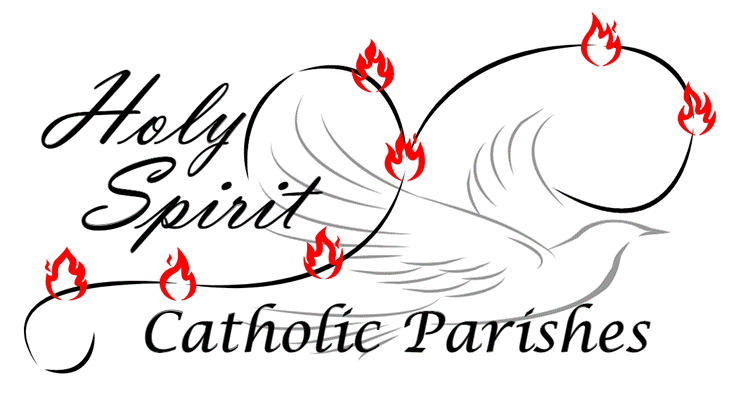History
Our Catholic History Part I
Being Catholic is deeply rooted in history, in the plan God has for our lives. We are reminded of this every time we read the Sacred Scriptures. Beginning in the Old Testament, salvation history tells how God called a nation, a people to be particularly his own. God didn’t limit salvation to the Jewish people, but desired everyone to be his people and he will be our God. Thus he sent his Son, Jesus Christ, to reconcile all people to the Father. Through baptism we have become adopted children of God.
Listen to a homily audio version of this history given by Fr. Vogel in 2023. Find Part 2 further down this page.
For us, this faith, to be children of God, has been passed down over the centuries through the preaching of the apostles and different saints, depending upon where our ancestors came from. For example, the Irish look back to St. Patrick (5th Cent), Germans to St. Boniface (8th Cent), and Czechs to Saints Cyril and Methodius (9th Cent), just to name a few.
The beginnings of the faith here in the rural parts of the Archdiocese of Omaha go back to the pioneer days. The following is a brief account of this heritage we have received in our Holy Spirit Catholic Parishes from our great-great-grandparents and the priests who brought them the Sacraments.
Let’s start in 1854 when the Nebraska Territory was formed, allowing settlers to move into the area. In 1862 the Homestead Act came into effect, increasing settlement. In the 1860s travel became easier for immigrants. Steam ships reduced the time and cost for immigrants to cross the Atlantic ocean. The desired transcontinental railroad line was constructed between 1863 and 1869, connecting Omaha to the California coast, bringing more people into Nebraska. Railroads meant accessibility to the rest of the world, including the ability to bring crops to market. The growth of all seven of our towns were affected by railroad lines that went through them. Randolph and Plainview each had two rail lines intersect at them, though today only the railroad along Highway 20 remains.
The Nebraska Territory (and our parish family) was settled east to west, starting along the Missouri River. The oldest Catholic community in Nebraska was
St. John City in Dakota County, founded by Fr. Jeremiah Trecy in 1856 with 25 Catholic families. The same year the first Catholic church in Omaha was built. By 1859 there were only 3 priests to help Bishop O’Gorman cover the 357,000 square miles of the Vicariate Apostolic of Nebraska Territory, which included not just Nebraska, but parts of Utah, Montana, and the Dakotas.
By 1859 there were only 3 priests to help Bishop O’Gorman cover the 357,000 square miles of the Vicariate Apostolic of Nebraska Territory, which included not just Nebraska, but parts of Utah, Montana, and the Dakotas.
The first Catholic settlers within the region of our 7 parish family made their homes around the Ponca and Newcastle area. Of our 7 towns, Ponca was the first to be formed, as the fourth oldest town in Nebraska. Before any churches were established, traveling priests, like Fr. Trecy, would pass through the area at rare intervals to offer Mass at homes. The first Catholic church to be built in our family was in 1873,
St. Peter’s in Newcastle. It would be nearly five more years before St. Peter’s received a resident priest, Fr. Michael O’Toole. Fr. O’Toole oversaw all of Dixon County and parts of Dakota and Cedar counties as well.
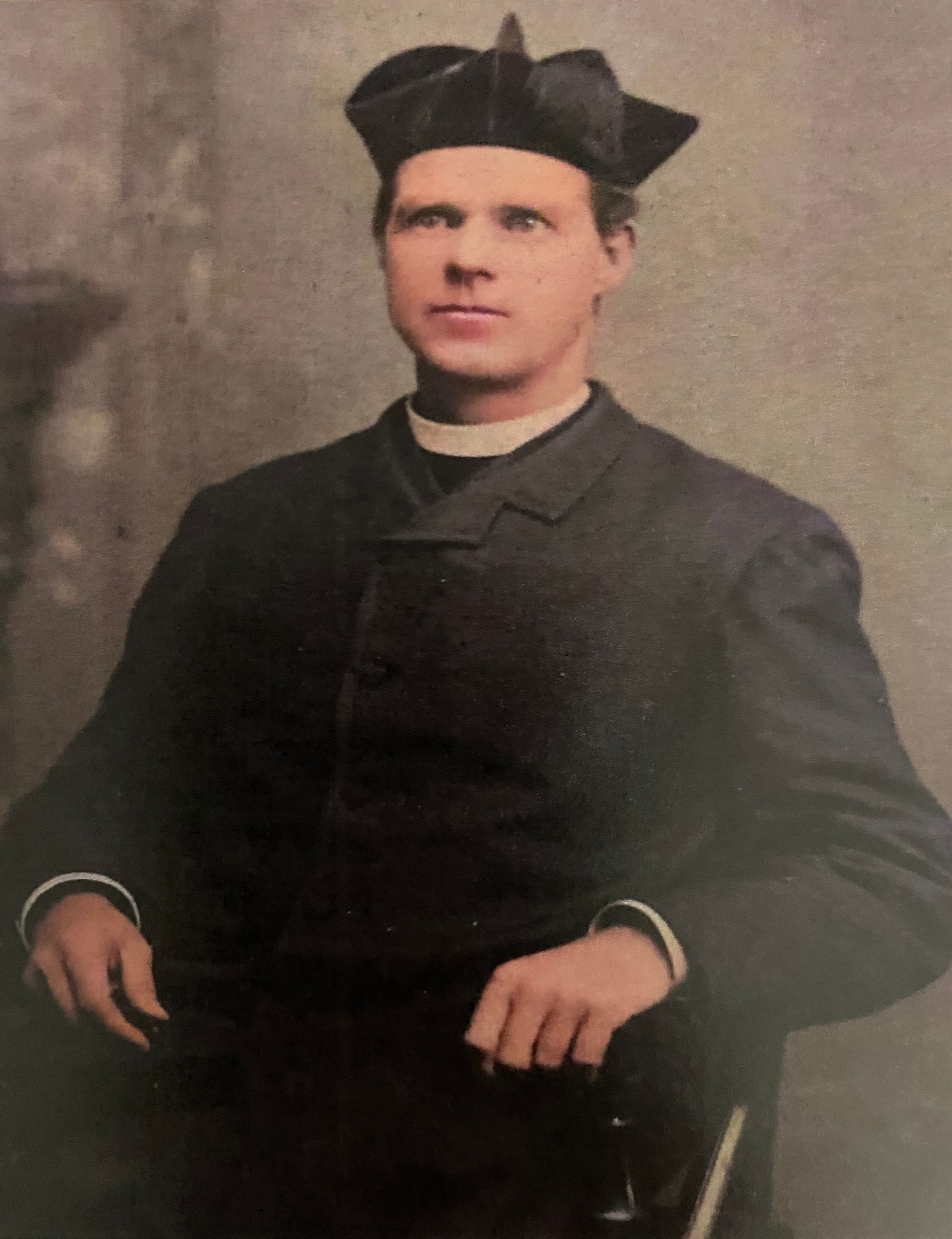
Fr. Michael O'Toole
Fr. O’Toole also served
St. Paul at South Creek which was the second church built in our area in 1875. Mass was said at Newcastle and South Creek on alternating Sundays. In 1878
St. John church at Willis was built, attended from St. Patrick, Jackson. And in 1883 Fr. O’Toole helped establish
St. Patrick Church at Tara Hill. Fr. O’Toole is buried in St. Peter’s Cemetery.
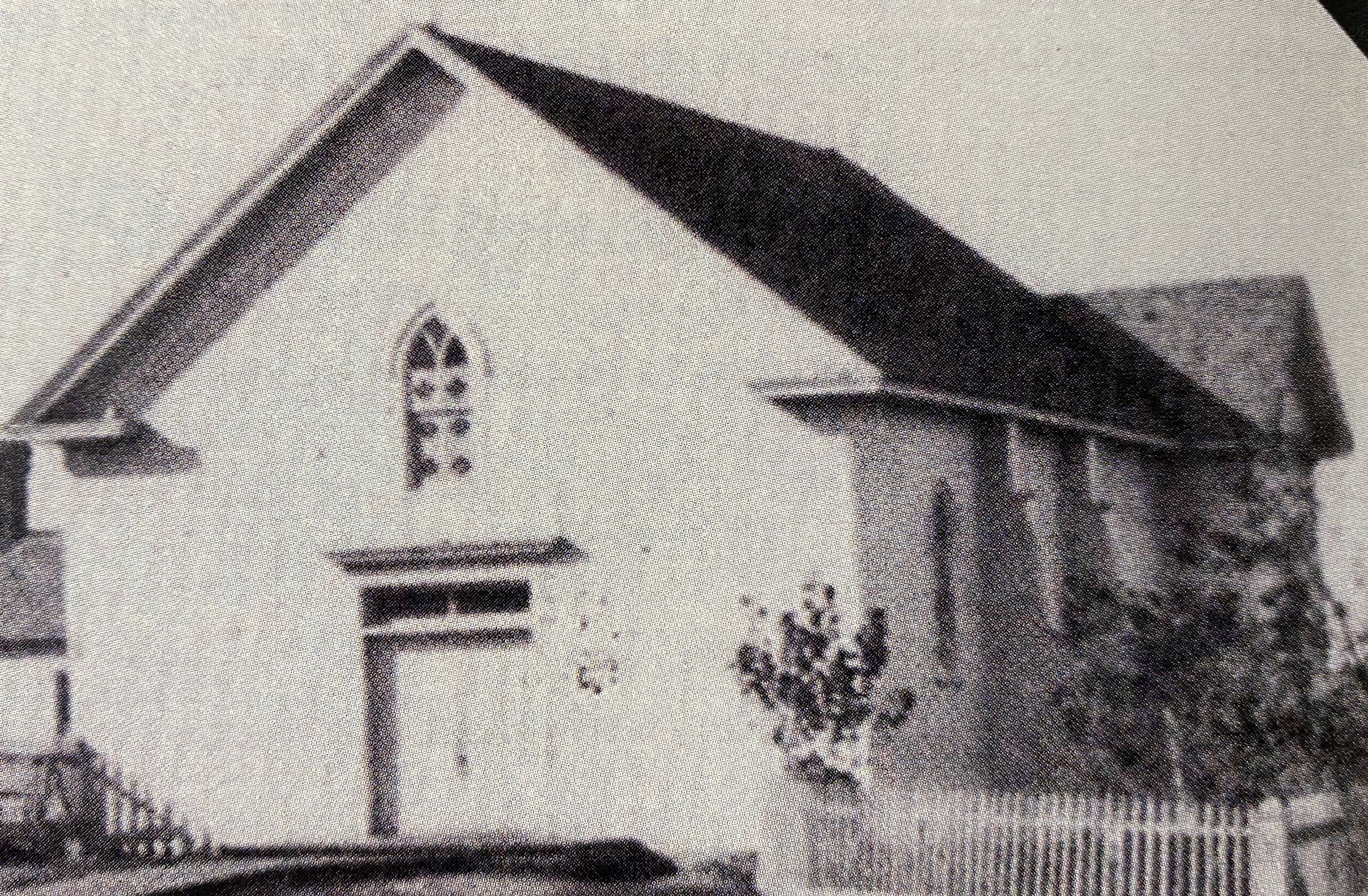
Holy Trinity, Hartington first church 1884-1903.
In Cedar County the first Catholic churches were north of our family at St. Helena and Bow Valley. The town of Hartington was founded in 1883. Many of the early settlers of Hartington were Catholic, so a church was built in 1884.
Holy Trinity received Mass once a month from the priests at St. Helena or Bow Valley. Then in 1886 Hartington received a resident pastor. Catholics about 7 miles east of Hartington in the East Bow Creek area had visiting priests celebrate Mass on occasion at the district school building until about 1887 when
St. Catherine’s church was built at East Bow served from Hartington.
It was also in 1887 that St. Michael in Coleridge was built, served as a mission first from Hartington and then Emerson.
While Ponca is the oldest town in our family, since Catholics had a church at South Creek, the first Catholic church wasn’t built in Ponca until 1890. From that point on
St. Paul, South Creek was attended from
St. Joseph in Ponca.
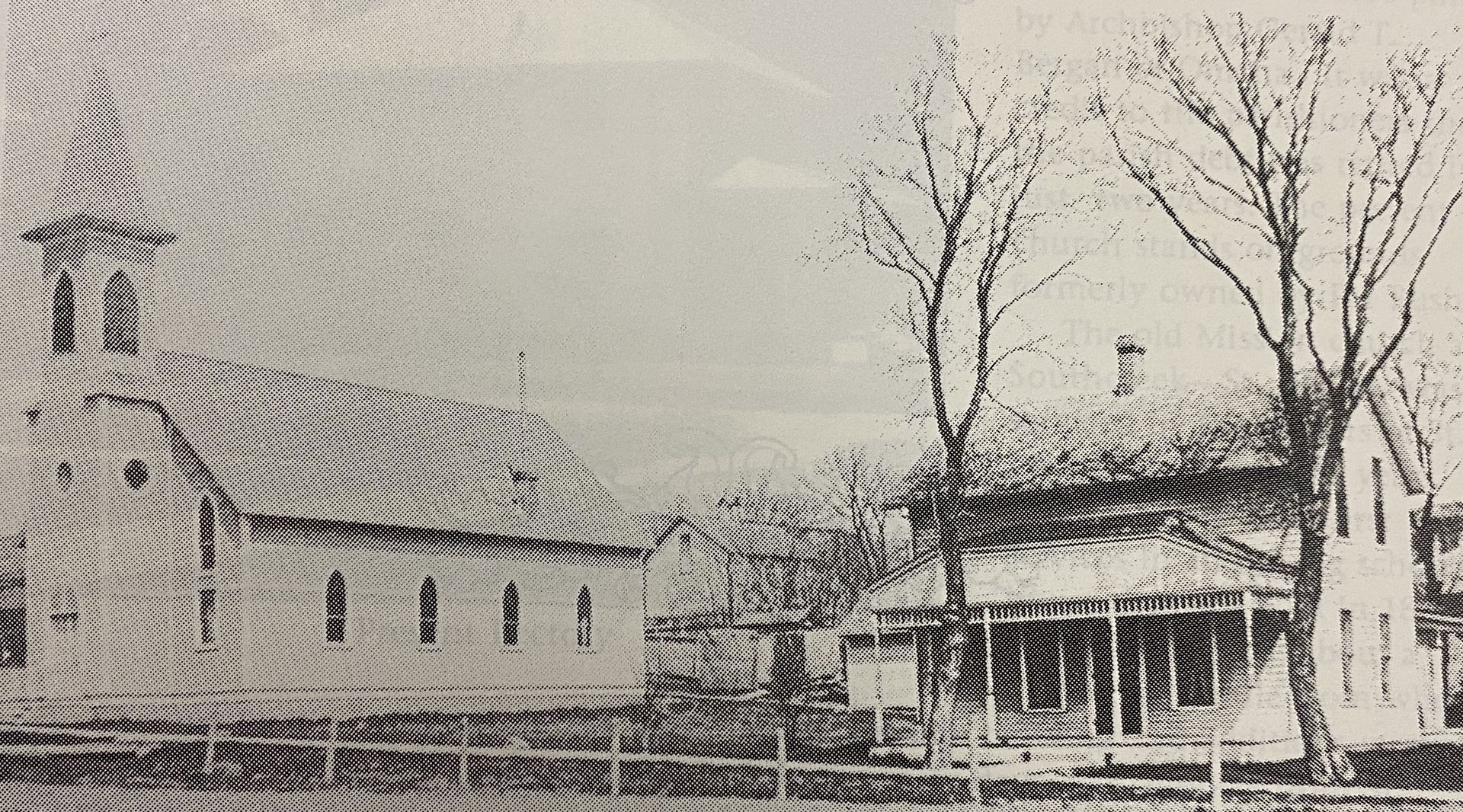
St. Joseph, Ponca second church and first rectory.
Like many of our parishes, Catholics in Randolph were initially served by visiting priests on an irregular basis, in particular from Hartington. Before a church was built in Randolph, Mass was held at the grocery store with the altar made of empty crates. A church was built, and the first Mass was celebrated there in 1892.
St. Jane Frances’ first resident pastor Fr. Hork, who came in 1884, almost left when parishioners struggled to provide him even enough for food.
In 1892 Msgr. Vranek at St. Ludger, Creighton began to organize a mission at Osmond. Before St. Mary’s church could be dedicated in 1897, it was destroyed by a tornado. This didn’t faze the congregation as they simply rebuilt it.
St. Mary’s in Osmond was initially served from Randolph, which is why all of the parish’s earliest sacramental records can be found in Randolph’s books. Catholics in Plainview completed a small brick veneer church in 1902, becoming a mission of St. Ludger, Creighton. When Osmond received their first resident pastor in 1904,
St. Paul, Plainview was served from there.
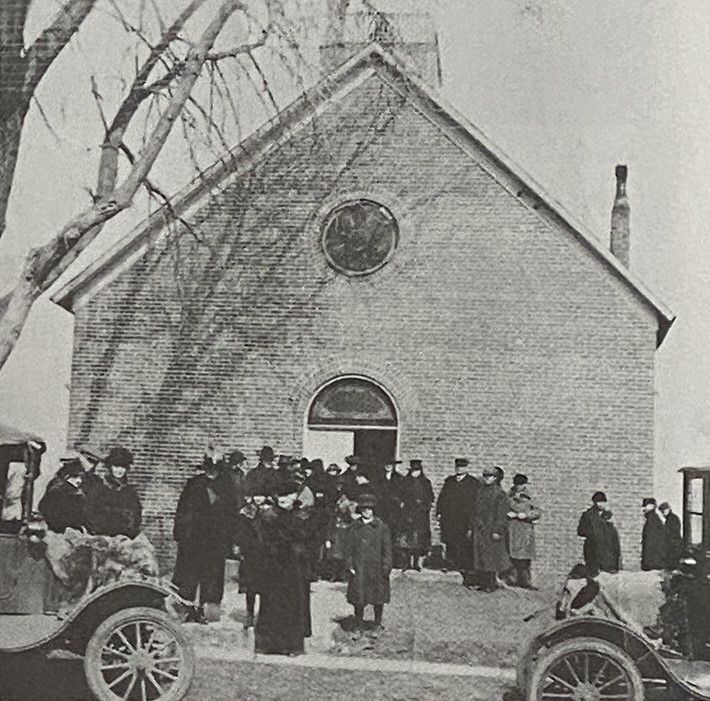
St. Paul, Plainview first church.
As time went on, a few other Catholic churches were built in close proximity to our parish family. In 1904, Our Lady of Sorrows was built in Carroll. At first a mission of St. Mary’s in Wayne, it later became a mission of St. Jane Frances, Randolph. In 1905, St. Mary in Belden was built, becoming a mission of St. Michael, Coleridge which had just received its first resident pastor. Also in 1905, Immaculate Conception church was built in Waterbury. Immaculate Conception would be connected to Jackson, Willis, and Ponca at various moments of its existence. Finally, in 1914 St. Francis church was built in Obert, as a mission of Ss. Philip and James church at St. James. (If you drive from Hartington to Newcastle you go through Obert, so I thought it fitting to include them.) So by 1920 our 7 parish family area actually contained some 15 churches. For more on the history of these and other former Catholic churches in the rural areas of the Archdiocese of Omaha, watch Fr. Vogel's Faith on the Frontier video series.
To summarize, our parish family was settled east to west, all parishes being founded within a span of 30 years. That means all of our parishes are over 120 years old –
St. Peter, Newcastle is the oldest, having celebrated their 150th Anniversary in May 2023, and
St. Paul, Plainview is the youngest at 121 years. It is interesting to note that for all seven, the parishes are older than their current churches. For all seven the first church doesn’t exist anymore; at least one newer church was built either for expansion or due to disaster like fire. Even though
Newcastle,
Hartington,
Coleridge and
Ponca are the oldest of our parishes, they have the newest churches built in the 1950s and 1960s.
St. Mary, Osmond may be the second youngest of our parishes, but it has the oldest church, dedicated in 1912. To read more detailed histories of the seven individual parishes in our family follow this link.
Our Catholic History Part II
Every follower of Jesus in every generation will have unique crosses, our ancestors had theirs and we have ours today. One common cross we have now is our
Journey of Faith changes. We are feeling the effects of decline within our rural areas. We might want the church in our area to continue to grow without difficulty or struggle. But historically that didn’t happen. The population in rural Nebraska reached its peak by 1930. Our rural population has been declining ever since. In 1930 our three counties (Dixon, Cedar and Pierce) had 39,000 people. Now we have about 21,000. Our current population is actually back to what we had in the 1890s.
Listen to a homily audio version of Part 2 of this history given by Fr. Vogel in 2023.
So, what did it look like back then, with regard to parishes and priests? In 1890, 78 priests were covering 151 locations. And those 78 priests were serving Catholics living in the combined area of the Omaha and Grand Island dioceses.) Compare that to today: last year we had 107 active diocesan priests covering 123 parishes. That means today we still have more priests covering fewer locations over a smaller area than priests were doing in 1890 when we had an equivalent rural population. Today we have 7 parishes being covered by two priests. In 1890, our family of parishes consisted of six church locations covered by two priests (resident at
Newcastle and
Hartington). (The parishes in
Randolph,
Osmond and
Plainview didn’t exist yet.)
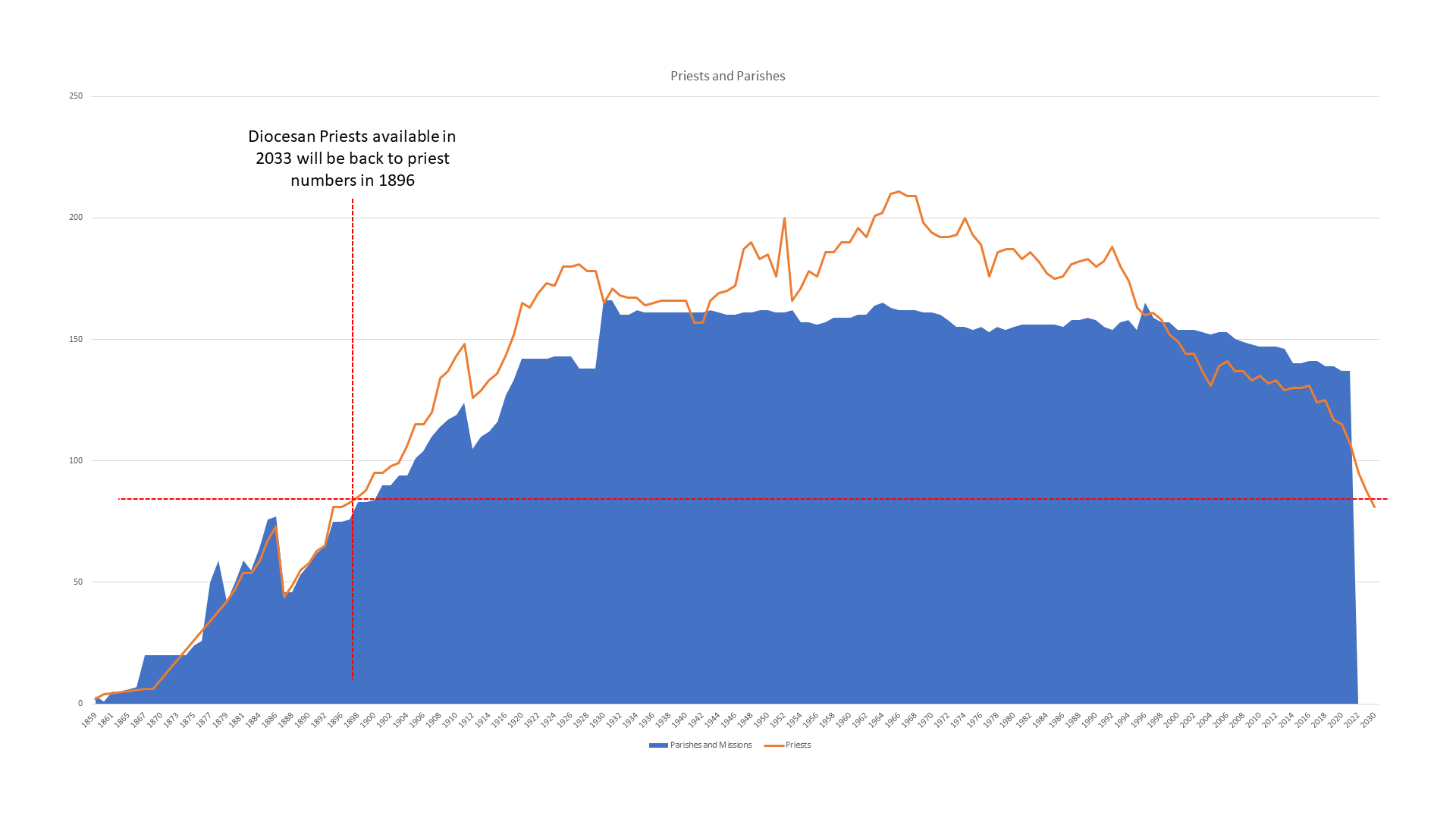
Priest and parish statistics for the Archdiocese of Omaha compiled from the Official Catholic Directories 1852-2022.
Most of the early priests came from other countries, like the immigrants they came to serve. We didn’t start having “enough” priests until our priests began coming from Nebraska itself, native-born priests from our own parishes and families living here. Our 7 parishes have given 22 sons as priests, though we have used the services of 157 priests through the years. By 1930, the height of rural population, there were 155 active diocesan priests and 55 religious order priests. By that point all 7 of our parishes had their own resident pastor.
Demographically, a significant phenomenon occurred from 1946 – 1964 known as the baby boom. During that time the number of baptisms in the Archdiocese went from about 3100 baptisms per year to peaking at about 7100 per year. Today we are back down to less than half that peak at about 3500 baptisms per year. As a result of the baby boom, there was also a boom in priestly vocations. By 1968, the height of priestly vocations, there were 209 active diocesan priests and 167 religious order priests. So over 40 years, priest numbers had an 80% increase.
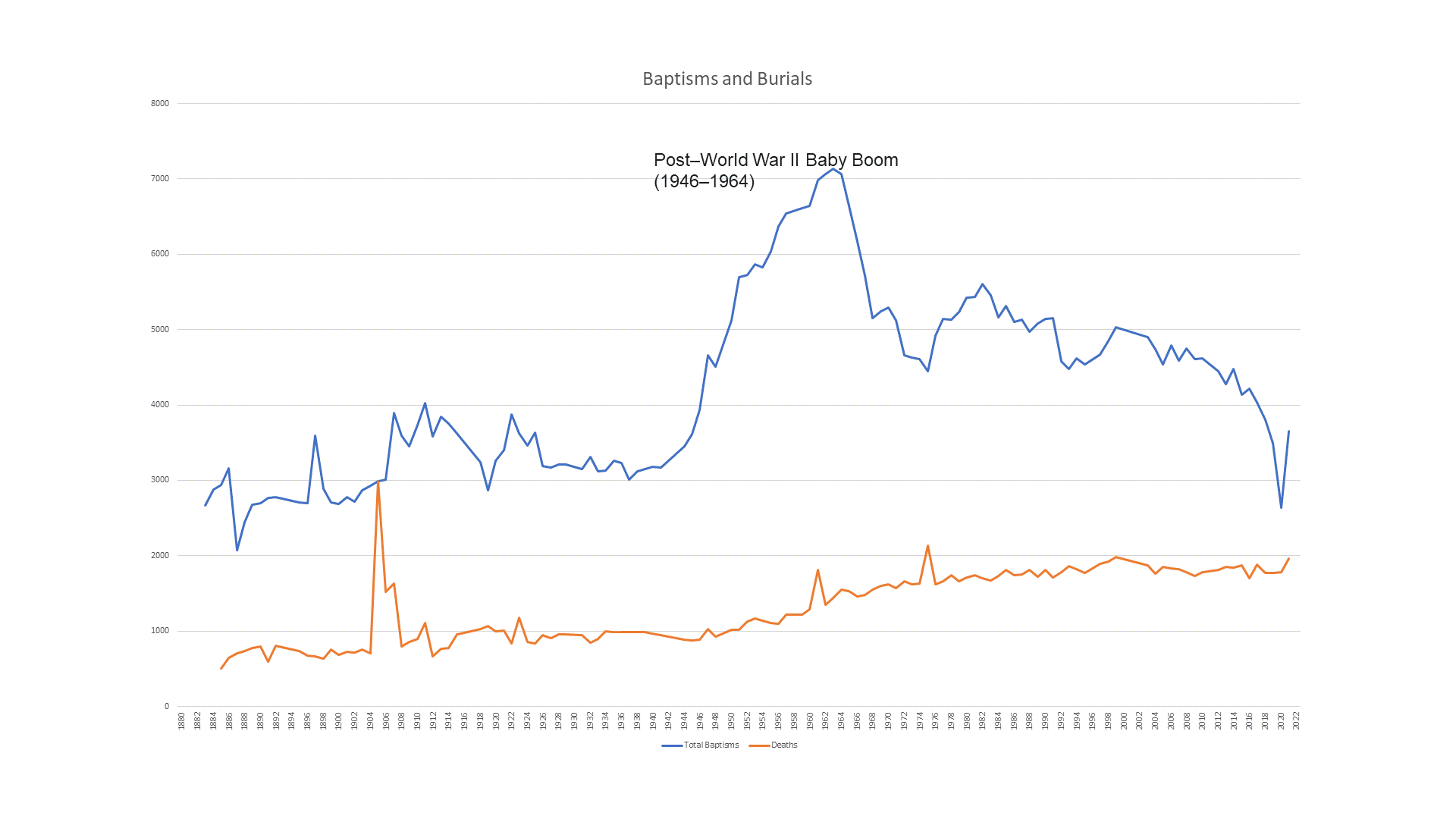
Baptism and burial statistics for the Archdiocese of Omaha compiled from the Official Catholic Directories 1852-2022.
During that same period, the net result of some parishes closing and some new ones being built, there was a net decrease of about 40 churches, related to the declining rural population. As I noted earlier there was once some 15 churches in our 7 parish family area. There was once a Catholic church in Allen, NE – St. Michael – which closed in 1913 after only 22 years. In 1951, St. Catherine at East Bow burned down and the same year St. Francis in Obert closed due to population decline. In 1969 St. Patrick, Tara Hill burned down and their 14 families joined Newcastle. In 1972 St. Paul at South Creek also burned down after being struck by lightning, its members joining Ponca. A year later in 1973, Our Lady of Sorrows in Carroll closed. Two years after that, the declining membership at St. John, Willis, led them to close. St. Mary, Belden and Immaculate Conception, Waterbury remained open until the early 1990s when their membership had dwindled as well. For more on the history of these and other former Catholic churches in the rural areas of the Archdiocese of Omaha, watch Fr. Vogel's Faith on the Frontier video series.
Population and parish numbers going down, and priest numbers increasing led to an experience of an abundance of priests. By 1968 all seven of our parishes still had resident pastors, with Hartington and Randolph each having an associate as well. In fact,
Randolph had two priests for 24 years straight, and
Hartington had two priests for nearly 100 years. But that temporary abundance following the baby boom wasn’t to last forever. We have tried to lengthen the time by assigning more and more parishes per priest, but the baby boom generation of priests are now rapidly nearing retirement. In 1968 there were 17 retired, sick or absent priests; in 2022 there were 81. This year alone we had 6 priests retire. In 1890 there were 78 priests; by 2033 we expect to be back down to 81. This means that both our rural population and our priest numbers have returned to 1890 numbers.
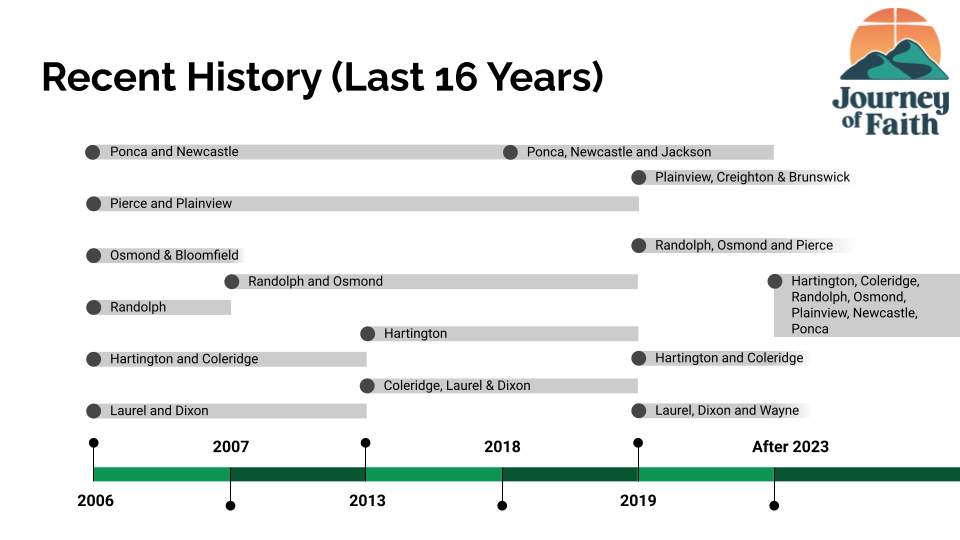
Timeline of recent changes to the parishes within Holy Spirit Catholic Parishes family, due in a large part to the declining number of priests and declining rural population.
“Each priest said Mass wherever he happened to be … vestments and sacred vessels were carried by the priests in his saddle bags … Priests of that period literally lived in the saddle.” Sr. Aquinata Martin
What it was like for those pioneer priests prior to 1890? One historian wrote, “Each priest said Mass wherever he happened to be … vestments and sacred vessels were carried by the priests in his saddle bags … Priests of that period literally lived in the saddle.” (Sr. Aquinata Martin,
The Catholic Church on the Nebraska Frontier (1854-1885), 1937, p. 52). That seems to be again the life of a rural priest – life in the saddle, back and forth between parishes, sometimes multiple times a day.
With the
Journey of Faith pastoral planning process, I have heard the sorrow: that our great-grandfathers built these church communities and now we are giving it all up. Has the work of our ancestors been all for nothing? When a church closes or when a parish doesn’t have a weekend Mass, does that mean all that we have done is abandoned? Not if we choose to remain faithful. And we can learn this from our forefathers who passed on the faith to us.

Our great-grandfathers left their established homes and churches – the churches their forefathers had built – with little to nothing to find a new life here in Nebraska. They lived in sod caves, battled blizzards, prairie fires, rattlesnakes and grasshopper plagues. Before they had their own churches they traveled by horse and wagon 15-20 miles to the nearest log cabin church. This was across the wild prairie where hardly a road existed, building makeshift bridges to cross the creeks. They arose early in the morning before dawn, arrived for Mass by about noon, stayed to share the lunches they brought as a community, and finished with mid-afternoon vespers, before making the long journey home to arrive after dark. This is the faith and determination that built our churches. What would the founding families of our parishes think of our complaints in traveling a few more miles – in our heated and airconditioned vehicles on established roads? The hardship of not having everything at our personal convenience? They gave up their homes and churches in Germany, Prussia, Bohemia, Poland, Ireland – but they did not give up their faith. Just because the place where Mass was to be celebrated changed, they gave nothing of their faith up, indeed it was only strengthened. They picked up their cross and followed Jesus. We can choose to do the same.
While Jesus promised that the gates of the netherworld would never prevail against the Church, he didn’t say we wouldn’t have to go through change and suffering. If we wish to return to a time with an abundance of Catholics and an abundance of priests to serve them, then we must take up the task of sharing the joy of the gospel in the midst of a suffering world. We cannot be unwelcoming to those from neighboring parishes, nor can we make excuses that the church has abandoned us, so we don’t have to make sacrifices. We are here to bring the message of forgiveness and reconciliation.
Our ancestors would ask us: what is the foundation of our faith? Wood, brick, and stone? Or the rock of Christ? Is our worship about one single location, or do we worship in spirit and truth Jesus wherever his Real Presence is? Are we ourselves not the living stones that make up the Church? Even if Mass ceases in one location or another this does not mean Jesus is no longer Lord. (cf. John 4:24, 1 Corinthians 3:9-16, 1 Peter 2:4-5)
As one parish history book said it, “A church is not a building, it is a people … It was our grandparents and great grandparents who courageously brought the faith to our beloved great plains … It is we who nurture this prized gift of faith … and as the future ancestors, will pass on the traditions of faith to those who follow.” (Introduction, 100 Years of Faith, St. Peter de Alcantara, Ewing, 1885-1985.)
Fr. Kevin Vogel 2023.
